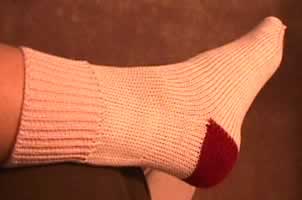Hey! If you're knitting socks at Pacifically Passap, send me pictures, and I'll post them at my blog. I wish I were there knitting with you! |
 Rosie's Sock,Shaped Sock Knitted on a Double BedFrom The Knitting Fiend.Rosie's problem: She won't wear shoes and she's worn holes in all her socks! My problem: I have lots and lots of left over yarn I acquired when I bought my used knitting machine. What to do? Well, I decided to write this "sock-u-lator" web page. I don't like long seams on my socks, so I made these socks on my Passap E6000, it's a double bed which permits me to knit circular. This page describes how to make these socks on the Passap. If you have a Japanese machine and a ribber, you will need to translate the lock setting to the appropriate carriage settings. You will also need to read how to short row on your machine. (It's really easy to short row on a Japanese machine, but it's done differently. ) If you are willing to measure your feet, you can make your own custom socks using the spare yarn around the house. Some advice about yarn. Need I even say it? Machine washable. The yarn should also be elastic, that way the ribbing will be springy. Acrylic and washable wool work well. If you want cotton socks, you will need to learn how to knit the ribbing along with a strand of woolly nylon. It really helps make the ribs springier, but I don't teach you how to do that on this page. Good luck.
|